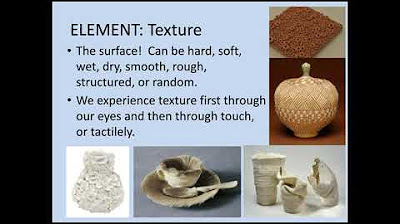The 7 formal elements of photography
Summary
TLDRThis video explores the seven formal elements of photography: line, shape, form, pattern, tone, color, texture, and space. It emphasizes how these elements can transform simple compositions into striking images by guiding the viewer's focus and adding depth, perspective, and mood. The video provides practical advice on how to observe and incorporate these elements into your photography, offering tips for experimenting with lighting, contrast, and composition. Understanding these elements is essential for developing your photography skills and enhancing your creative vision.
Takeaways
- 😀 Lines in photography can guide the viewer's eye and create a sense of depth, particularly through techniques like leading lines and vanishing points.
- 😀 Shape and form can transform two-dimensional objects into striking three-dimensional subjects, emphasizing contours and volume through lighting techniques.
- 😀 Patterns, whether natural or man-made, can add rhythm and visual interest to your shots, often enhanced by even or varied lighting.
- 😀 Tone is essential in black-and-white photography, guiding the viewer’s attention through contrasts and light-dark relationships.
- 😀 Color can convey emotions and set the mood of your image. Bold colors make a statement, while contrasting a single color against a neutral background can create focal points.
- 😀 Texture gives your images a tangible quality, especially in macro photography, where it invites tactile engagement through lighting and depth of field.
- 😀 Space helps create depth in an image and emphasizes the subject. Negative space can isolate the subject and provide breathing room in the composition.
- 😀 Combining multiple formal elements, like lines, shape, and color, can significantly enhance the visual impact of your photos.
- 😀 Experimenting with light, contrast, and depth of field can bring out the best in texture and form, creating dynamic and engaging compositions.
- 😀 Understanding and applying formal elements in your photography will help elevate your skills and create more visually compelling and cohesive images.
Q & A
What are formal elements in photography?
-Formal elements are visual features, such as line, shape, form, pattern, tone, color, texture, and space, that photographers should be aware of when composing their images. These elements have the potential to transform simple subjects into great shots by adding structure and emphasis to the composition.
How do leading lines enhance a photograph?
-Leading lines guide the viewer's eye through the composition or direct attention to a focal point in the image. These lines can be straight, curved, angular, or random, and they help create a sense of depth or draw the viewer into the scene.
What is a vanishing point, and how can it be used in photography?
-A vanishing point is where two angular lines converge into a single point on the horizon, adding perspective and depth to an image. It is often seen in scenes like roads or railway tracks, where the lines appear to disappear into the distance.
What is the difference between shape and form in photography?
-Shape refers to a 2D outline of a subject, while form refers to a 3D representation of that subject. Both can be used effectively in compositions to create striking focal points, with lighting techniques such as backlighting and shadows enhancing their impact.
Why are patterns important in photography?
-Patterns, including symmetry and repetition, make interesting subjects in photography. By recognizing these patterns in the environment, photographers can create visually compelling compositions. Flat light often helps emphasize the repetitive nature of patterns, while 3D patterns may require specific lighting setups.
How does tone affect a photograph?
-Tone refers to the variation in light and dark areas of an image, which adds depth and guides the viewer's attention. In black and white photography, tone is crucial as it compensates for the absence of color and helps create contrast, emphasizing the image's focal points.
What role does color play in a photograph?
-Color in a photograph can make a bold statement or evoke specific moods. By using prominent colors or a harmonious color palette, photographers can create emotional impact. Additionally, a single color can be highlighted to make it stand out in the composition.
How can texture enhance a photograph?
-Texture adds a tangible, almost sensory quality to an image, making it feel more lifelike. It is particularly popular in macro photography, where the details of surfaces can be highlighted through lighting setups and depth of field to draw the viewer's attention to intricate details.
What is the importance of space in a photograph?
-Space in a composition creates a sense of scale and adds depth to the image. It can also provide breathing room around the main subject, allowing the viewer to focus on the key elements of the scene. Space is particularly effective in outdoor photography or when emphasizing large geographical features.
How can combining multiple formal elements improve a photograph?
-By combining various formal elements such as lines, shape, color, and texture, photographers can create more dynamic and compelling compositions. The interplay between these elements enhances the overall visual impact and adds complexity, making the image more engaging and aesthetically pleasing.
Outlines

هذا القسم متوفر فقط للمشتركين. يرجى الترقية للوصول إلى هذه الميزة.
قم بالترقية الآنMindmap

هذا القسم متوفر فقط للمشتركين. يرجى الترقية للوصول إلى هذه الميزة.
قم بالترقية الآنKeywords

هذا القسم متوفر فقط للمشتركين. يرجى الترقية للوصول إلى هذه الميزة.
قم بالترقية الآنHighlights

هذا القسم متوفر فقط للمشتركين. يرجى الترقية للوصول إلى هذه الميزة.
قم بالترقية الآنTranscripts

هذا القسم متوفر فقط للمشتركين. يرجى الترقية للوصول إلى هذه الميزة.
قم بالترقية الآنتصفح المزيد من مقاطع الفيديو ذات الصلة

THE 7 ELEMENTS OF INTERIOR DESIGN EXPLAINED | CREATE THE PERFECT SPACE

7 Elements of Interior Design

9 Design Elements You Need To Know In Under 360 Seconds

Elements and Principles 3D Art - Google Slides

Lecture: Formal Elements and Principles of Design

Paintings in CHINA, Japan and Korea | Lesson 1 | ARTS 8 | Weeks 1-3 | Quarter 2 | MELC Based
5.0 / 5 (0 votes)
